Formalwear
Topic: Choosing Formalwear for Bridal Party/Family Members
Timeframe: Four Months
Compared to selecting a wedding gown, the choice of formalwear is far more straightforward, dictated largely by the season, time and formality of the wedding. The groom’s attire should complement that of the bride and fall within etiquette guidelines.
Tuxedo Styles
Formal evening weddings dictate a black tailcoat—cut short in front and extending to tails in the back. This is worn with a white, wing collar shirt and pleated black trousers. Accessories can vary with the degree of formality desired.
For a semi-formal evening wedding, the classic black tuxedo or dinner jacket with a black tie and cummerbund are popular choices. A white dinner jacket is acceptable between Memorial Day and Labor Day, or for a wedding in the tropics any time of year. A dark suit is also acceptable for a semi-formal wedding.
The formal daytime wedding calls for a cutaway coat in dark gray worn with gray striped trousers. A white wing-collar shirt and ascot or tie completes the look. The groom may also choose a top hat, spats and matching gray gloves.
The look for a semi-formal daytime wedding is a gray stroller with pinstripe trousers. This is worn with a turned-down collar shirt, tie, buttoned vest and pinstriped trousers. A suit is also an appropriate choice.
Informal evening and daytime ceremonies call for a simple black suit, or navy blue jackets with light-colored trousers.
Attendants
For a touch of contrast, the ushers’ formalwear should differ from that of the groom. This can be achieved by changing the color of the bow ties or by having the ushers wear a completely different style or color of tuxedo.
If you wish to have male guests wear formal attire, simply add the notation, “Black tie invited” to the lower left corner of the reception invitation.
To complete your wedding, consider the ring bearer’s attire. He can match the groom from head to toe, or simply dress him identically to the ushers. I f a flower girl is to be his partner, you may wish to have his accessories match her gown.
The father’s tuxedo need not match the groom’s or the ushers’, since his formalwear will match or accent his wife’s gown. He can also wear his own tuxedo if he has one. Another nice touch is to invite grandfathers to wear tuxedos.
Shopping for Formalwear
You should begin shopping for formalwear at least four months prior to the wedding. Allow additional time if you are planning to marry in May or early June to avoid prom season. The groom should try on several different styles of jackets and trousers before deciding. Also try on several different vests and cummerbunds to see which will best suit your wedding. The bride should bring swatches from the bridesmaids’ and mothers’ gowns to match or contrast colors. The groom can also model the groomsmen’s attire if it is different from his.
Most formalwear shops include all accessories, except shoes, in the rental price. Be certain the rental agreement includes that information and also lists additional charges.
Once you have selected the men’s attire, arrange to have the members of the wedding party fitted a minimum of six weeks in advance. All formalwear should be rented from the same shop, even for out-of-town attendants. Also, be sure all of the attendants have matching socks.
Attendants not living locally should be professionally measured at a formalwear shop since tuxedo measurements differ slightly from those of regular suits. There may be a small fee for this service. Have them send their measurements as quickly as possible.
Trying on Formalwear
The groom and groomsmen should try on their tuxedos two-to-three days before the wedding in case more alterations are needed. At this fitting, the groom and attendants should check the following:
1. Make sure jacket fits comfortably and lapels lay smoothly over the chest.
2. All sleeves should be h emmed to show the same amount of shirtsleeve.
3. Trousers should be hemmed to just break over the front of the shoe.
4. Make sure shoes and accessories fit, and that colors match.
Returning Formalwear
Most formalwear shops offer optional insurance for a nominal fee that covers excessive damage.
Each groomsman is responsible for paying for the rental of his outfit, including shoes. The groom may elect to give his attendants gifts in the form of cuff links and studs, monogrammed pocket squares or unusual suspenders.
After the wedding, each groomsman should assemble his attire and deliver it to the best man or other specified person who will return all rented items to the tuxedo shop.
Questions for Formalwear Specialist
1. What formalwear styles best suit the time and formality of my wedding?
They will be able to point you in the right direction and offer many options that will be appropriate.
2. What is included in the rental price?
Are shoes and accessories included or extra?
Important Money Saver Tip: Be sure to get the total tuxedo price including shoes, cummerbund or vest, and accessories in writing for the entire wedding party.
To prevent accidental overcharging, let the groomsmen know in advance what they will pay and what’s included when picking up their tuxedos.
3. Are all alterations included in the price?
Also ask if second alterations are needed, are they also covered in the price?
4. When will the formalwear be available for final fittings and pickup?
Have all members try on their tuxedos three days before the wedding in case more alterations are needed.
5. When must the formalwear be returned?
Also inquire aboutwhat happens if a tuxedo is damaged. Do they offer insurance?
Be sure to check out the Formalwear Worksheet and Formalwear Chart under: For Brides: My Bridal Suite





 '
'









